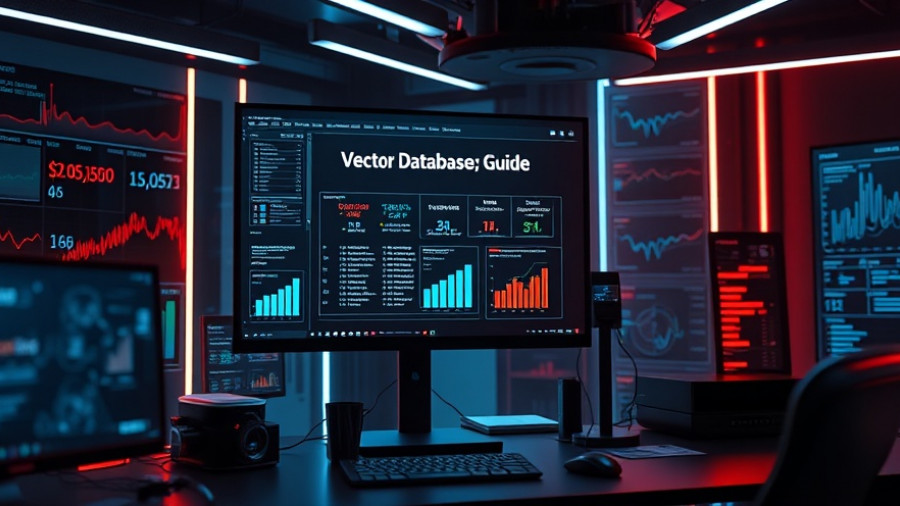
The Rise of Vector Databases in Machine Learning
In today's rapidly evolving landscape of machine learning, vector databases have emerged as essential tools for small and medium-sized businesses seeking to leverage AI effectively. Unlike traditional databases that excel in exact matches, vector databases cater to high-dimensional embeddings, making them invaluable when the need for semantic similarity search arises.
Why Traditional Databases Fall Short
Traditional databases operate efficiently with fixed schemas and exact queries. However, when businesses aim to enhance user experience through recommendations or semantic searches, they quickly uncover the limitations of these systems. For instance, a query like "best Italian restaurants nearby" transforms into a complex high-dimensional vector that demands considerable computational resources. With millions of entries, with each query requiring billions of calculations, traditional databases simply can’t keep pace. This is where vector databases shine.
The Technology Behind Vector Databases
Vector databases utilize specialized algorithms for approximate nearest neighbor (ANN) searches. Rather than relying on exhaustive searches through all available vectors—which can be computationally prohibitive—these databases reference advanced data structures that allow them to quickly identify a streamlined subset of candidates. By using techniques such as hierarchical graphs and spatial partitioning, they efficiently narrow down to relevant items without compromising search quality.
Key Algorithms to Know: HNSW, IVF, and PQ
Several core algorithms drive the functionality of vector databases. Hierarchical Navigable Small World (HNSW) graphs, Inverted File (IVF), and Product Quantization (PQ) are just a few examples. HNSW emphasizes speed and recalls while maintaining a navigable structure. IVF is designed for effective partitioning, ensuring rapid access to data points. On the other hand, PQ compresses information, optimizing storage while still enabling a fast retrieval process. Understanding these algorithms can help businesses select the right vector database for their requirements.
Tuning for Performance: Recall vs. Latency
One of the critical decisions businesses must make is balancing recall and latency—understanding that they might need to sacrifice some accuracy for speed. In high-traffic applications where immediate results are crucial, the capability of a vector database to deliver rapid responses can provide a significant competitive edge. Thus, fine-tuning these parameters matters greatly to meet the business's objectives.
The Advantages of Embracing Vector Databases
Adopting vector databases grants several unique benefits, particularly for small and medium businesses:
- Scalability: As datasets grow, vector databases handle larger volumes without compromising performance.
- Enhanced user experience: They enable personalized and contextually relevant recommendations, keeping users engaged.
- Cost Efficiency: With optimized processing times, businesses can potentially save on cloud costs associated with computing resources.
Real-World Applications of Vector Databases
Many industries are already experiencing the transformative effects of vector databases. In e-commerce, they're utilized for recommender systems to suggest products based on customer preferences. In healthcare, vector databases assist in medical imaging analysis by finding similar cases based on patient histories. Financial institutions are leveraging them for fraud detection by computing an analysis of transactions against known fraudulent activities. The adaptability across sectors showcases the flexibility of vector databases.
Choosing the Right Vector Database
When considering implementation, businesses have several options, including Pinecone, Weaviate, Chroma, and Qdrant, among others. It’s crucial to assess each database's strengths and weaknesses relative to your business's specific requirements. Key factors to keep in mind include ease of integration, vendor support, and cost of ownership versus the potential ROI based on improved system efficiencies.
Conclusion: The Path Forward for Businesses
Vector databases are proving indispensable for businesses that want to remain competitive in an increasingly data-driven world. They not only solve the limitations of traditional databases but also provide a strategic advantage in how companies can interact with and analyze their data. As small and medium companies venture into AI-driven solutions, leveraging vector databases will become a pivotal aspect of growth.
To better position your business for success, explore the introduction of vector databases into your tech stack today! Understanding how they can improve your operations and user experiences can set you apart in the crowded marketplace.
 Add Row
Add Row  Add
Add 



Write A Comment